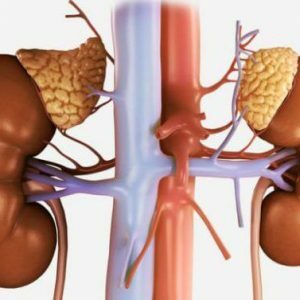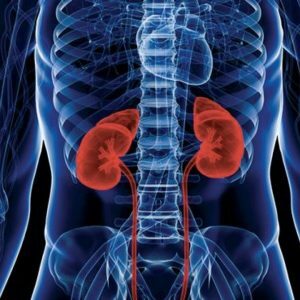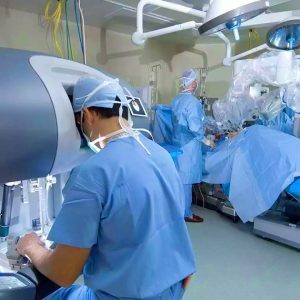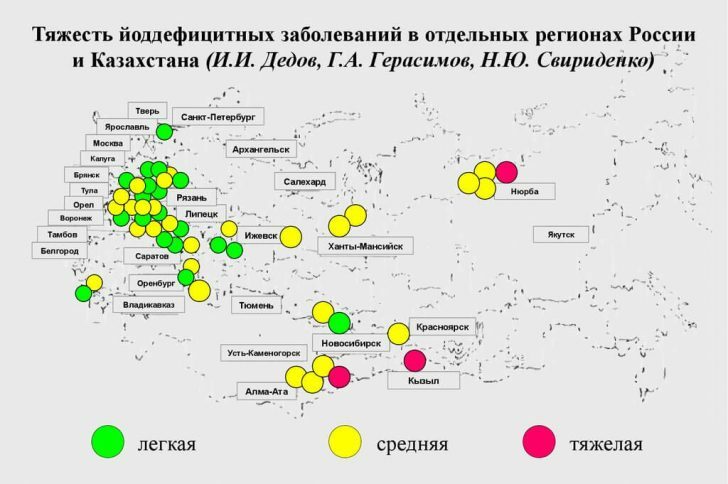Aldosteroma of the adrenal: symptoms and treatment

Aldosteroma is a tumor that is localized in the adrenal region.The tumor is formed from the cellular structures of the adrenal cortex and leads to the development of Crohn's disease.According to statistical data, patients in the age category from 30 to 50 years are most affected by this pathology.
Table of contents: Summary of pathology Causes of Aldosteroma: symptoms of pathology What is the danger of aldosterome?Diagnostic methods Treatment of aldosteromeShort description of the pathology of
In most cases, aldosteroma is benign in nature and is characterized by increased hormonal activity.
Note: This tumor formation, as a rule, is localized in the region of one adrenal gland.Only in 5% of cases is diagnosed bilateral aldosterome.
This disease affects the cardiovascular system and the patient's visual apparatus. Most pathology develops with adrenal adenoma, but sometimes aldosteroma is formed against the background of hyperplasia of the adrenal cortex and hormonally active tumor neoplasms in the ovaries or thyroid gland.
What does it come from?
The exact causes of adrenal aldosterome formation have not been established to date. However, doctors identify a number of factors capable of provoking the development of this pathological process.
It is customary to include the following:
-
 endocrine system diseases;
endocrine system diseases; - genetic predisposition;
- disorders of the adrenal function;
- adrenal adrenal gland;
- weakened immune system;
- hormonal disorders;
- traumatic injuries;
- processes of an inflammatory nature that occur in the region of the adrenal glands or kidneys.
Important! According to statistical data, the adrenal aldosterome is most affected by the fair sex.This pathology is diagnosed in women 3 times more often than in men!
Aldosteroma: symptoms of pathology
Symptomatic of adrenal aldosterome is quite numerous and diverse. In order not to get confused in clinical signs, the specialists divided them into three main groups: renal, cardiovascular and neuromuscular syndromes.Let's consider the manifestations of each of them in more detail.
The main symptoms of renal syndrome characteristic of aldosteroma include the following symptoms:
- increased thirst;
- increased urge to urinate;
- disorders of renal concentrating ability;
- nocturia( frequent trips to the toilet at night);
- polyuria( rapid urge to urinate);
- Nephropathy;
- decreased urinary density.
Neuromuscular syndrome with adrenal aldosterome develops due to a lack of elements such as potassium and magnesium .
As a result, the following clinical signs begin to appear in patients:
- increased fatigue;
- paralysis;
- constipation;
- muscle weakness;
- convulsive syndrome;
- muscular dystrophy;
- Somatic disorders, localized in the hands and feet of the patient.
Signs of cardiovascular damage in case of aldosterome are caused by excessive production of aldosterone, as well as fluid retention in the body, resulting in increased hormonal sensitivity of the vessels.
Against the backdrop of these pathological processes, the following symptoms of aldosterome manifest themselves in patients:
-
 impaired visual function;
impaired visual function; - increase in blood pressure indicators;
- headaches;
- heart rate irregularities;
- pain in the heart;
- myocardial dysfunction.
Important! If the neoplasm in the adrenal region is of a malignant nature, the patient exhibits clinical signs such as fever, pain in the abdomen, general weakness and excessive sweating!
Unfortunately, in approximately 10% of cases, the pathological process with the adrenal aldosterome is asymptomatic, which greatly complicates the diagnosis and subsequent therapy!
What is the danger of aldosterome?
The lack of adequate, timely treatment and neglect of the pathological process with the adrenal aldosterome can lead to the development of the following extremely dangerous and undesirable complications:
-
 Diabetes mellitus.It develops due to the disorder of the processes of insulin synthesis and the increased sensitivity of cellular structures to glucose.
Diabetes mellitus.It develops due to the disorder of the processes of insulin synthesis and the increased sensitivity of cellular structures to glucose. - Stroke.Due to a sharp increase in blood pressure, characteristic of adrenal aldosterome.
- Renal failure.It occurs against the background of kidney damage and increased creatinine levels.This condition is accompanied by increased edema and general intoxication of the body.
- Hypokalemic crisis.This is one of the most dangerous complications of adrenal aldosterome, manifested by headaches, convulsive syndrome, heart rhythm disturbances, nausea and vomiting.If you do not give the patient timely help, there is a high probability of falling into a coma, the emergence of acute disorders of coronary circulation and even death.
- Visual impairment, up to absolute blindness.
Aldosteroma is a dangerous pathology, therefore, when the first characteristic signs appear it is necessary to seek professional medical help from an endocrinologist.
Important ! Blood pressure changes, weakness, frequent urination, frequent attacks of head and heart pain may indicate the development of adrenal aldosterome, and therefore should serve as a good reason for going to the doctor!
Diagnostic methods
When diagnosing adrenal aldosteroma, great importance is given to the study of complex symptoms, analysis of the collected results of anamnesis and patient complaints. In addition, patients with suspected adrenal aldosterone are assigned the following types of diagnostic studies:
- A laboratory blood test aimed at determining the indices of aldosterone;
- ultrasound examination;
- computed tomography;
- magnetic resonance imaging;
- taking a biopsy to identify the nature of tumor growth;
- phlebography;
- radioisotope scanning;
- laboratory test of urine.
Note : Complex diagnostics makes it possible to reveal the nature and dimensions of the tumor formation localized in the adrenal region, which is important for determining the most effective, adequate treatment tactics!
Treatment of aldosterome
 To date, the only effective and effective way to combat adrenal aldosterome is surgical treatment aimed at removing tumor tumors, as well as the most affected adrenal gland .If the tumor is not too large, then resection is performed, which allows to keep part of the adrenal gland.
To date, the only effective and effective way to combat adrenal aldosterome is surgical treatment aimed at removing tumor tumors, as well as the most affected adrenal gland .If the tumor is not too large, then resection is performed, which allows to keep part of the adrenal gland.
Methods of drug therapy can have only a symptomatic effect, temporarily improving the patient's condition, but not relieve the disease itself.
Important! Surgical operation to remove adrenal aldosteroma allows achieving positive results in 70% of clinical cases!
Preparing for operation
 In order for the surgical treatment to be as effective and safe as possible, the patient must be properly prepared for the operation. As a rule, the process of preparation for surgery takes about 2 weeks.At this time, the patient must comply with a special diet, which consists in the exclusion of the daily diet of salty foods and products containing sodium.
In order for the surgical treatment to be as effective and safe as possible, the patient must be properly prepared for the operation. As a rule, the process of preparation for surgery takes about 2 weeks.At this time, the patient must comply with a special diet, which consists in the exclusion of the daily diet of salty foods and products containing sodium.
In addition, a course of drug therapy, which includes potassium preparations, as well as drugs such as Aldactone and Veroshpiron.In order to prevent the possible development of postoperative complications, patients are prescribed glucocorticoid preparations( Hydrocortisone, Cortisone and others).
Types of surgical treatment
For the removal of adrenal aldosteroma, modern specialists can use the following methods of performing a surgical procedure:
- Open surgery, in this case removal of tumor growth, is carried out in the traditional way.With the help of a surgical scalpel, an incision of the skin is made in the area of intersection of the muscular groups of the diaphragm and the walls of the peritoneum, which provides access to the affected adrenal gland.After removal of the tumor, sutures are applied.
- Retroperitoneoscopic technique - less traumatic and more gentle procedure.To access the tumor and the adrenal gland expert, several punctures and a small incision are made in the back area of the patient.This method is characterized by the most accelerated rehabilitation period.
- Laparoscopic surgery is one of the most modern and minimally invasive methods for removing adrenal aldosteroma.Before the beginning of the procedure, a specialist enters carbon dioxide into the abdominal cavity of the patient, and the operation itself is performed through small punctures made in the region of the anterior abdominal wall.
The optimal method of surgical intervention with adrenal aldosterone is determined by a specialist individually !In this case, the doctor takes into account such factors as the size of the tumor, the severity of the pathological process, the age category and the overall health of the individual patient!
Recovery period
During the postoperative period after surgical intervention aimed at removing adrenal aldosteroma, the patient needs special care, so he must be in the clinic, under constant medical supervision.
Note: The average length of the rehabilitation period after removal of aldosterome is from a week to 10 days( in the absence of possible postoperative complications).
 During the recovery period, the patient continues to follow the prescribed diet with a reduced salt content of .Patients are also prescribed potassium-containing drugs and aldosterone antagonists.
During the recovery period, the patient continues to follow the prescribed diet with a reduced salt content of .Patients are also prescribed potassium-containing drugs and aldosterone antagonists.
Medication after surgical intervention should be aimed at strengthening the patient's immune system and suppressing the production of aldosterone.
For these purposes, specialists often use such an immunostimulating drug as the Transfer Factor.
This medication is characterized by the following therapeutic properties:
- Normalization of the functioning of the endocrine system.
- Strengthening of the immune system and activation of natural defense mechanisms in the patient's body.
- Neutralization of "alien" antigens.
- Elimination of unwanted reactions, the development of which was provoked by the prolonged use of various medications.
This complex action gives an extremely positive effect during the recovery of patients after surgical treatment of adrenal aldosterome, reduces the risks of possible complications and relapses.
It is also important to monitor the patient's condition in the post-operation period by controlling the electrocardiogram indices and the electrolyte level.
Note: In general, the medical prognosis for this disease, in the case of benign neoplasm, is quite favorable!
Prevention of the development of adrenal aldosteroma is the timely treatment of kidney diseases and endocrine disruptions.
In order to achieve positive results in the treatment of aldosterome, timely diagnosis and referral to the specialist at the initial stages of the development of the pathological process is of great importance!
Elena Sovinskaya, medical reviewer



